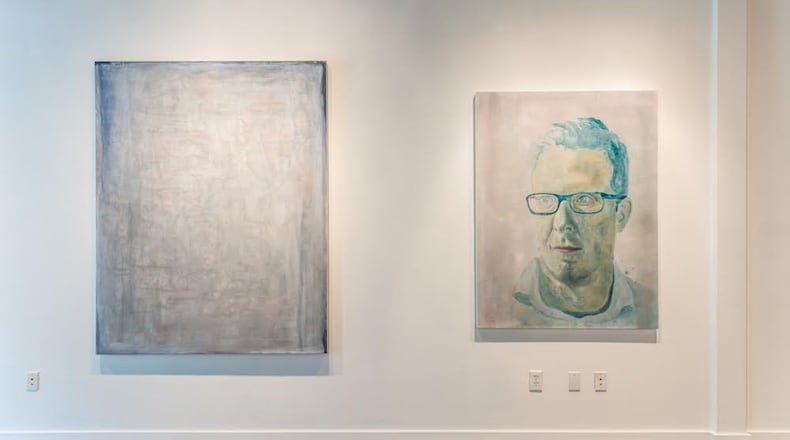For much of his exhibition history in Atlanta, artist Mark Leibert has focused on the natural world: flowers and plants and landscapes — lovely, if occasionally wispy subjects influenced by his childhood amid the flora and fauna of Hawaii.
It turns out Leibert may have been hiding his light under a bushel. In his latest exhibition "Reflex" at Sandler Hudson Gallery, Leibert shows a serious finesse with portraits in a notable departure from work that was lovely though never quite as resonant as these strange, intriguing portraits.
Rendered in oil and acrylic on canvas and on paper, Leibert’s large portraits have the soft, pastel dimension of watercolors, with delicate, muted brushstrokes. Leibert’s skill with his medium, his ability to convey mood and a slightly dreamy dimension through his use of color and technique is quite compelling. His subjects appear to be drawn from the artist’s own peer group, roughly of the same age and sensibility, like characters in an indie film based on the director’s own life.
Leibert’s choice of color — a chalky palette of blues, pinks and grays — lends his subjects an ethereal quality, as well as an offbeat, slightly cartoonish tone enhanced by their expressions and attitudes. “Gather,” a portrait of a pensive man in dark-rimmed glasses and red lips, is done in weepy, smudged shades of blue that intensify a sense of mild disquiet already present in the man’s expression and posture. Like a sand castle threatened by the next wave, Leibert’s subjects look like they could easily wash away, hovering between something concrete and something ephemeral.
In “Shift,” a wiry woman with angular features and blue-black hair twists her arm and hand into a strange contortion. There’s a bit of weirdness in the colors, in her posture; it’s a hard-to-pinpoint feeling of something off-kilter that accompanies all of these intriguing paintings.
“Tracking” may be the most self-possessed of Leibert’s subjects, perhaps because his posture in profile, gazing away from us, suggests less desire to please or address our gaze. But the soft pinks in the painting’s background blend the divide between man and environment, and a sliver of green on one side of the image suggests some other reality, a background behind the pink one, a slippage of something more real, that makes us question the reality before us.
In two smaller portraits whose watery, smeared colors even more fundamentally evoke watercolors, Leibert’s subjects seem to dissolve into the air as if dematerializing. In “Switch,” a man’s features are vaporous, indistinct and the contours of his hair drip and molt. In “Untitled (Blank Series),” Leibert’s subject’s features are almost indecipherable, swaths of color and line bleeding into nothingness.
Less satisfying than these portraits that play with our desire to discern and know something from contemplation of the human face are the abstract works Leibert has paired with the portraits. In a statement, the artist says these works are inspired by “glitches”: imperfect Polaroids, ruined film, battered VHS tapes. Those works, with their hazy, indistinct surfaces suggesting water damage or the patina of corroded metal, are mixed in among Leibert’s portraits. Left to their own devices, Leibert’s portraits have plenty to say, and these experiments in color gradations and pattern can feel like fussy experiments that confuse rather than enlarge the merit of his more successful paintings.
IN OTHER NEWS:
ART REVIEW
“Mark Leibert: Reflex”
Through July 8. 11 a.m.-5 p.m. Tuesdays-Fridays; noon-5 p.m. Saturdays. Free. Sandler Hudson Gallery, 1000 Marietta St. NW, Suite 116, Atlanta. 404-817-3300, www.sandlerhudson.com.
Bottom line: Some memorable portraits become mired in ambiguity when placed next to abstract works in an otherwise intriguing solo show.
About the Author
Keep Reading
The Latest
Featured





